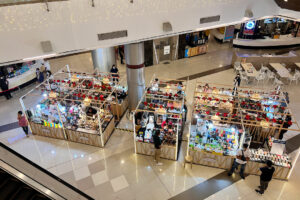MSMEs prioritize digital adoption to tackle economic challenges — experts
PHILIPPINE MICRO, small, and medium enterprises (MSMEs) demonstrate resilience in addressing economic uncertainties through swift digital adoption, leveraging platforms such as e-commerce and social media, according to industry experts.

By Miguel Hanz L. Antivola, Reporter
PHILIPPINE MICRO, small, and medium enterprises (MSMEs) demonstrate resilience in addressing economic uncertainties through swift digital adoption, leveraging platforms such as e-commerce and social media, according to industry experts.
Digital transformation is now crucial for MSMEs, arising from the necessity for lean and efficient operational alternatives to recover from crises, Armando “Butz” O. Bartolome, founder and president of GMB Franchise Developers, said in an interview with BusinessWorld.
“MSMEs have started to recover gradually but not really skyrocket,” he said.
“We are not really there yet, but I can see a lot of entrepreneurs are gung ho about how things are going,” he added. “They know the past is past. It’s a hard lesson to accept, but they really have to move forward and adapt.”
“If they’re not online, they’re not going to be in business.”
MSMEs are the backbone of the economy, accounting for 99.59% of all business establishments and employing 65.10% of the workforce, according to the Philippine Statistics Authority. Small businesses created 5,607,748 jobs last year.
“In 2023, it was more of a ‘rebasing era’ for us,” noted Rosemarie B. Ong, chairwoman of the Philippine Retailers Association (PRA), referring to the persistent economic uncertainties marked by price fluctuations, high inflation, and supply chain disruptions from the Russia-Ukraine and Israel-Palestine wars.
Mr. Bartolome said that MSMEs have to stay informed to navigate through such challenges with limited resources. “We are not the decision-makers, but find out how much these situations will affect you.”
“The growth will depend on how you innovate. It’s high time to realign the types of services you can now provide to adapt and consider the investments you can make to lower costs,” he added, emphasizing continuous recalibration as a sign of the times.
In terms of consumer behavior, he observed a stronger ‘sachet mentality,’ with Filipinos increasingly preferring layaways, segmented payment schemes, and installments when accessing products and services.
This also means exploring emerging technologies such as artificial intelligence (AI) and automation to improve efficiency, which Jose Ma. “Joey” A. Concepcion III, founder of the Philippine Center for Entrepreneurship-Go Negosyo, noted as an inclusive opportunity, which entrepreneurs are bound to embrace in the face of risks.
“We tell them that you have to ride. It’s never a straight flight,” he said. “There will be bumps, and that’s part of business.”
E-COMMERCE
The Philippines’ digital economy is projected to grow by 13% this year, reaching $24 billion in gross merchandise value, according to the e-Conomy report by Google, Temasek Holdings, and Bain & Co.
This growth will be primarily driven by e-commerce, expected to expand by 21% annually and reach $24 billion by 2025.
According to the GoDaddy 2023 Data Observatory report, around 95% of Philippine small business have planned investments in online sales and marketing spending this year. It also found that 62% reported generating up to half of their annual revenue from online sales channels.
E-commerce platforms have become an avenue for MSMEs to participate in growing digital opportunities such as shoppertainment, which aims to attract consumers with content to help drive sales. It is projected to expand to a market value of over $1 trillion by 2025, according to the Boston Consulting Group.
Danecia Reverie Fojas, senior account manager at TikTok Shop, noted how MSMEs often find it challenging to compete with established brands in traditional retail spaces, and how a creative digital storefront democratizes the scene and helps entrepreneurs grow.
“There is a fundamental shift in consumer-based brand interactions, and consumers now seek engaging, exciting, educational, and entertaining experiences with brands,” said Life Dawn Cervero, vertical head for food and beverage at TikTok Philippines.
“Advertising their brands is now very inclusive with the shift to social platforms. The dynamics have changed,” Mr. Concepcion said. “We’re teaching them how to become nano-influencers able to market themselves and their product.”
Shopee reported a fiftyfold increase in orders on Shopee Live, an interactive live-streaming feature on the e-commerce platform, during its 12.12 mega sale, which resulted to 12 million items sold across markets in just the first two minutes.
The surge in livestream shopping led to a forty-sixfold increase in new buyers locally, emphasizing the trend’s popularity, it added.
“I’m very bullish and optimistic that the whole digitalization move is helping more entrepreneurs next year,” Mr. Concepcion said.
DIGITAL TRANSFORMATION
But more than sales, digital platforms have also allowed small businesses to unlock efficiency from the backend, improving their access to suppliers and distributors.
“We have found that an information gap in product selection, stocking, and marketing prevents digital empowerment for MSMEs, especially those in rural areas and from disadvantaged groups,” Ms. Fojas said as the industry’s top risks, which can be alleviated by empowering everyone to seize the opportunities of the digital economy.
Mr. Concepcion noted that digital transformation is increasingly being pushed for sari-sari stores, as they are significant players among retail MSMEs, which are often easy to overlook.
There are about 1.3 million sari-sari stores in the Philippines, which 94% of consumers depend on for daily needs, according to the Asian Preparedness Partnership. Excluding those without paid employees, there are 40,549 sari-sari stores in the country, according to the local statistics agency.
Ibrahim R. Bernardo, co-founder and chief marketing officer at Packworks, said that providing enterprise resource planning solutions and tech support for sari-sari stores has begun opening up possibilities for both their present and future.
This includes inventory management, insights dashboards, and a customer relationship management system, which collectively elevate sari-sari store owners as key opinion leaders in their respective communities, he added.
“Access to brands, helping their businesses with tools specific to them, margin protection — there are many ways we’re helping the stores, but the challenges are still there,” he noted. The majority of stores aided by Packworks have increased sales, “doing better with the app than without it.”
“We amplify and put those super sari-sari stores on a podium and give them tools so that the smaller stores are inspired and emulated,” he said on directing efforts to maximize the potential of small community retailers.
“There are so many possibilities once you get them connected and provide value,” he added, envisioning sari-sari stores soon becoming an affordable internet provider, job placement hub, and dark warehouse, with a committed vision and support for a high-tech future for them.
ARTIFICIAL INTELLIGENCE
However, with the rapid emergence of sophisticated technologies such as AI, entrepreneurs are faced with the challenge of balancing technology costs with efficiency gains.
The Trade department earlier said that AI could contribute as much as $90 billion to the Philippine economy by 2030.
However, only 17% of Philippine organizations are ready to utilize and deploy AI, with the majority of them raising concerns about the impact of not adopting these advances, according to a recent report by technology company Cisco.
It said that 44% of Philippine organizations are chasers or moderately prepared, 35% are followers with limited preparedness, and 4% are laggards with no readiness to leverage AI.
“While tech adaptation is crucial, affordability remains a key factor,” PRA’s Ms. Ong said regarding MSMEs’ limited financial capacity for tech advancement. “In any technology, there’s always a cost associated with it, especially since [AI] is still a work in progress.”
“If you introduce AI solutions, it should align with the basic needs and affordability of MSMEs, not just because it’s a trend,” she added, emphasizing the importance of identifying specific pain points that AI can address, which vary for each business.
“[AI] is not a one-stop solution. It is about how you use it,” Mr. Bartolome said. “Learn and understand how AI can be productive for you. It’s something that cannot just sit down and work for you. You have to ensure you can control and modify it to meet your needs.”













